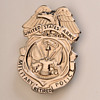Posted 10 years ago
 Chrisnp
Chrisnp
(310 items)
Among the most colorful uniforms of the French Army were those of its colonial troops. “Tirailleur” is a term dating back to Napoleon for skirmishers - light infantry who fought ahead of the advancing columns. Eventually it became the title for light infantry regiments raised in the French colonies mainly in Africa, although some were also in French Indochina
The braid on the sleeve indicates the owner was a first lieutenant. As an officer, he would be a Frenchman in charge of Africans, and not ethnically African himself. The blue tabs on his yellow collar would have originally included his regimental number. The nine brass buttons are spherical, except for the bottom button which is an old replacement. The six decorative buttons on the back are half spheres with Maurice Bourdon, Paris back marks, which date this piece to no earlier than 1918. The jacket features a slit at the side (visible at the back) for attaching a sword to a belt worn under the jacket. The jacket is fully lined with two inside pockets.
As shown in the illustration, the jacket would have been worn with scarlet trousers and a blue and scarlet kepi, the colors worn into the field in 1914.






















stunning!!!
You came thru again for us. Thought that red was universally accepted by Euro as meaning artillery as well as many other countries? Great item!
I always look forward to your comments, Blunder. Actually red trousers and caps were pretty typical colors in the French army, although the M.C. Hammer style parachute pants (how many here are too young to get that reference?) were more specific to colonial troops.
Does make it an easy target to pick out. Reminds one of the Zouaves of the U.S. Civil War & don't think they wore that clown outfit throughout the war.
“Éliminer le pantalon rouge? Jamais ! Le pantalon rouge, c'est la France!” (Get rid of the red pants? Never! The red pants, that's France!) - Eugene Etienne, War Minister, in a cabinet meeting on the subject of issuing less conspicuous uniforms, 1913.
“To the right and above us lay Hill 325 still covered with fog. In the tall fields of grain on its southern slope, we could not recognize friend or foe. Off to the right and about a half mile ahead of us on the far side of a draw, we saw the red breaches of French Infantry in company strength on the front edge of a yellow Wheatfield behind fresh earthworks.” Then Lieutenant Erwin Rommel, describing his first battle in which his riflemen made easy targets of the French, 1914.
Actually, the French had designed a less conspicuous “horizon blue” uniform just prior to the war, but it wasn’t in large enough quantities to be general issue when the war broke out. It was about the color of this jacket. The horizon blue uniform was mediocre concealment at best, and then only when you were standing above the horizon line with bushes in front of you. British khaki or German field grey worked much better.